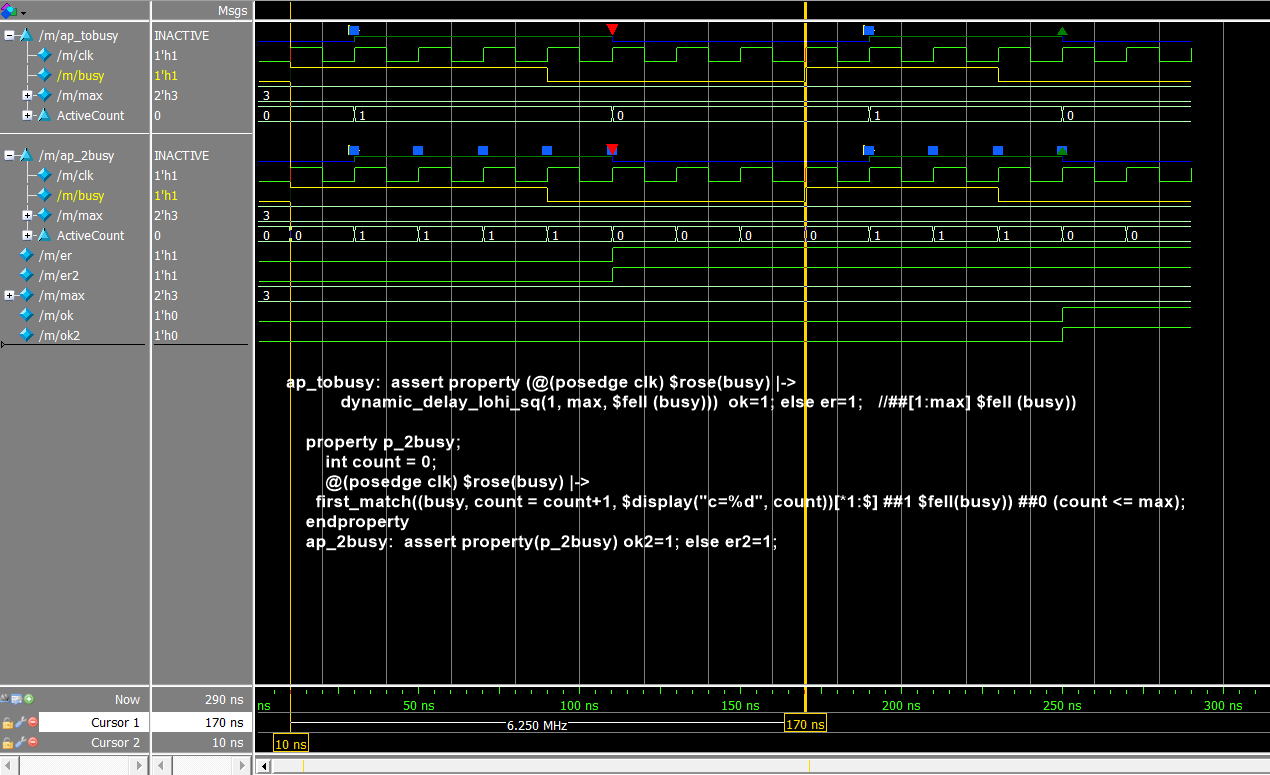In reply to Shubhabrata:
module m;
// from
// import sva_delay_repeat_range_pkg::*;
bit busy, er, ok, clk;
bit[1:0] max=2'b11;
initial forever #10 clk = !clk;
sequence dynamic_delay(count);
int v;
(count<=0) or ((1, v=count) ##0 (v>0, v=v-1) [*0:$] ##1 v<=0);
endsequence // dynamic_delay
sequence dynamic_delay_lohi_sq(d1, d2, sq);
int v1, vdiff;
( (1, v1=d1, vdiff=d2-d1) ##0 dynamic_delay(v1) ##0
(vdiff>=0, vdiff=vdiff - 1)[*1:$] ##0 sq);
endsequence
assert property (@(posedge clk) $rose(busy) |->
dynamic_delay_lohi_sq(1, max, $fell (busy))) ok=1; else er=1; //##[1:max] $fell (busy))
initial begin
$dumpfile("dump.vcd"); $dumpvars;
@(posedge clk) busy<= 1'b1;
repeat(3) @(posedge clk);
busy<=1'b0;
repeat(3) @(posedge clk);
$finish;
end
endmodule
- Your code has errors. This is what you meant
property p_2busy;
int count = 0;
@(posedge clk) $rose(busy) |->
first_match((busy, count = count+1, $display("c=%d", count))[*1:$] ##1 $fell(busy)) ##0 (count <= max);
endproperty
// **** The first_match is not need here, SEE MY LASR RESPONSE
ap_2busy: assert property(p_2busy) ok2=1; else er2=1;
FUll code + waveforms:
module m;
// from
// import sva_delay_repeat_range_pkg::*;
bit busy, er, ok, ok2, er2, clk;
bit[1:0] max=2'b11;
initial forever #10 clk = !clk;
sequence dynamic_delay(count);
int v;
(count<=0) or ((1, v=count) ##0 (v>0, v=v-1) [*0:$] ##1 v<=0);
endsequence // dynamic_delay
sequence dynamic_delay_lohi_sq(d1, d2, sq);
int v1, vdiff;
( (1, v1=d1, vdiff=d2-d1) ##0 dynamic_delay(v1) ##0
(vdiff>=0, vdiff=vdiff - 1)[*1:$] ##0 sq);
endsequence
ap_tobusy: assert property (@(posedge clk) $rose(busy) |->
dynamic_delay_lohi_sq(1, max, $fell (busy))) ok=1; else er=1; //##[1:max] $fell (busy))
property p_2busy;
int count = 0;
@(posedge clk) $rose(busy) |->
first_match((busy, count = count+1, $display("c=%d", count))[*1:$] ##1 $fell(busy)) ##0 (count <= max);
endproperty
// the first_match() is needed here to test the count.
ap_2busy: assert property(p_2busy) ok2=1; else er2=1;
initial begin
$dumpfile("dump.vcd"); $dumpvars;
@(posedge clk) busy<= 1'b1;
repeat(4) @(posedge clk);
busy<=1'b0;
repeat(3) @(posedge clk);
//
repeat(1) @(posedge clk);
busy<=1'b1;
repeat(3) @(posedge clk);
busy<=1'b0;
repeat(3) @(posedge clk);
$finish;
end
endmodule
// sim
# c= 1
# c= 2
# c= 3
# c= 4
# c= 1
# c= 2
# c= 3
Code
Ben
